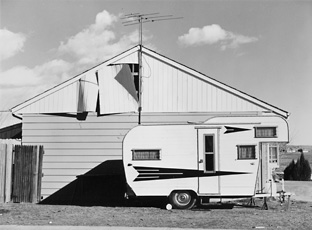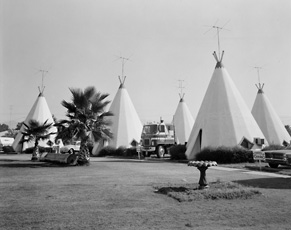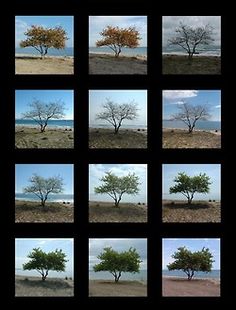What is the meaning of new Topographics?
New topographics was a term coined by William Jenkins in 1975 to describe a group of American photographers (such as Robert Adams and Lewis Baltz) whose pictures had a similar banal aesthetic, in that they were formal, mostly black and white prints of the urban landscape.
What is Topographics?
Technique in which a scene—usually a landscape—is photographed as if it were being surveyed from afar, practiced most famously by the 1970s ‘New Topographics’ photographers, including Robert Adams, Lewis Baltz, Nicholas Nixon, and Bernd and Hilla Becher.
What was the new topographics a reaction to?
Their stark, beautifully printed images of this mundane but oddly fascinating topography was both a reflection of the increasingly suburbanised world around them, and a reaction to the tyranny of idealised landscape photography that elevated the natural and the elemental.
Post-war America struggled with
- Inflation and labor unrest. The country’s main economic concern in the immediate post-war years was inflation. …
- The baby boom and suburbia. Making up for lost time, millions of returning veterans soon married and started families…
- Isolation and splitting of the family unit, pharmaceuticals and mental health problems
- Vast distances, road networks and mobility

A turning point in the history of photography, the 1975 exhibition New Topographics signalled a radical shift away from traditional depictions of landscape. Pictures of transcendent natural vistas gave way to unromanticised views of stark industrial landscapes, suburban sprawl, and everyday scenes not usually given a second glance. This restaging of the exhibition includes the work of all 10 photographers from the original show: Robert Adams, Lewis Baltz and etc.
MOODBOARD






The New Topographics documented built and natural landscapes in America, often capturing the tension between natural scenery and the mundane structures of post-war America: parking lots, suburban homes, crumbling coal mines. The photographs, stark and documentary, are often devoid of human presence. Jenkins described the images as “neutral” in style, “reduced to an essentially topographic state, conveying substantial amounts of visual information but eschewing entirely the aspects of beauty, emotion, and opinion”.
Robert Adams


On the one hand, New Topographics represented a radical shift by redefining the subject of landscape photography as the built (as opposed to the natural) environment. To comprehend the significance of this, it helps to consider the type of imagery that previously dominated the genre in the United States.
An example
Robert Adams

This image is a perfect example as the bottom half of the image is man-made with human activity objects as humans adapt which ultimately adds these subjects to the image. This contrasts to the top half off the image as it contains natural scenery therefore Robert Adam’s had contained both environmental factors. A significant feature about this image are the lines on the houses contrasting with the round/ not straight lines on the mountains showing clear meaning the houses are man-made and perfectly put together however the mountains are not but as humans we prefer the look of environmental features but housing is a necessity. Another interesting factor is the sun shining creating light highlights on the houses but in the distance dark shades with the clouds making light onto the floor which has an eye catching effect.
While visiting the exhibition, people voiced a range of reactions:
“I don’t like them—they’re dull and flat. There’s no people, no involvement, nothing.”
“At first it’s stark nothing, but then you look at it, and it’s just about the way things are.”
“I don’t like to think there are ugly streets in America, but when it’s shown to you—without beautification—maybe it tells you how much more we need here.”
TYPOLOGY – the study and interpretation of types that became associated with photography through the work of Bernd and Hilla Becher
Landscape/Typology. The German artists Bernd and Hilla Becher, who began working together in 1959 and married in 1961, are best known for their “typologies”—grids of black-and-white photographs of variant examples of a single type of industrial structure.
A photographic typology is a single photograph or more commonly a body of photographic work, that shares a high level of consistency. This consistency is usually found within the subjects, environment, photographic process, and presentation or direction of the subject.
To create these works, the artists travelled to large mines and steel mills, and systematically photographed the major structures, such as the winding towers that haul coal and iron ore to the surface and the blast furnaces that transform the ore into metal. The rigorous frontality of the individual images gives them the simplicity of diagrams, while their density of detail offers encyclopaedic richness. At each site the Becher’s also created overall landscape views of the entire plant, which set the structures in their context and show how they relate to each other. The typologies emulate the clarity of an engineer’s drawing, while the landscapes evoke the experience of a particular place. The exhibition presents these two formats together; because they lie at the polar extremes of photographic description, each underscores the creative potential of the other.
A landscape typology is a systematic classification of landscape types based on attributes that describe properties of interest, such as land use, scenic properties, or cultural characteristics or history.
EXAMPLE


